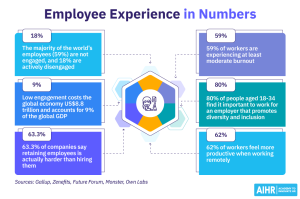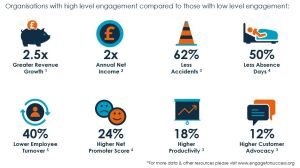Introduction
In today’s corporate world, employee engagement and experience are crucial not only for retaining top talent but also for overall organizational success. Even capital-heavy legacy firms would concur with the new reality of assets in the form of human potential given the shifts in generational thought processes. Here’s why companies that prioritize employee experience tend to observe higher productivity and better job satisfaction:
1. Employee Experience
Employee experience encompasses everything from how an employee feels, observes, and addresses their journey within an organization. From the pre-recruitment process to the day-to-day work interactions, until eventually the offboarding process, every engagement shapes the overall experience. A positive experience leads to enhanced job satisfaction for the employee, higher productivity, and reduced turnover rates. Above all, the employee feels ownership, and thereby higher level of ownership is observed, which is reflected in aspects like employee referrals, better innovation, etc.
A well-rounded employee experience strategy includes the following:
- First impressions matter. A welcoming, smooth, and comprehensive onboarding process helps new hires integrate seamlessly, understand their roles, and feel valued.
- A positive and inclusive work culture fosters collaboration and innovation. Comfortable physical workspaces and supportive remote work policies also play a crucial role.
- Opportunities for learning and growth are essential to help employees see a clear path toward advancement and have access to professional development resources.
- Acknowledging employees’ achievements creates a sense of belonging and appreciation in turn boosting morale and motivation through rewards and recognition.
2. The Role of Employee Engagement

Employee engagement goes hand in hand with employee experience. Engaged employees are emotionally invested in their work, ushering them to go above and beyond their job responsibilities, leading to higher productivity and innovation, notwithstanding, the employer brand value!
Employee engagement can be enhanced in the following ways:
- Effective Communication: Open, honest, and frequent communication helps employees feel informed and valued. Encouraging feedback and acting on it shows that the organization listens and cares. Close looping on communication is a key aspect.
- Empowerment: Giving employees autonomy and sufficient freedom to make decisions in their roles, fosters a sense of ownership and accountability.
- Work-Life Balance: Supporting employees in achieving a healthy work-life balance through flexible work arrangements and wellness programs reduces burnout and increases engagement. In an hour of need, without an ask from management, the employee gives his/ her/their 200%.
- Team Building: Regular team-building activities and social events can strengthen bonds.
3. Measuring and Improving Employee Experience and Engagement
To improve employee experience and engagement, organizations must attempt to measure these areas accurately. Tools like employee surveys, feedback systems, and objective performance metrics provide valuable insights into how employees feel and perform.
Based on these insights, companies can implement initiatives such as:
- Tailoring development opportunities to individual employees’ needs and career aspirations.
- Creating diverse and inclusive recognition programs that celebrate achievements at all levels.
- Investing in employee well-being through mental health resources, fitness programs, and ergonomic workspaces.
- Equipping managers with the skills to lead effectively, communicate well, and inspire their teams.
- Wherever possible, in small ways, organizations can focus on engaging family members, since loyalty gets built also at a family/ social level
- Structured & periodic Skip Level discussions, Stay Interviews (in line with Exit Interviews), and New Manager Assimilation Programs are a few ways to ensure the feelings and thoughts at the ground level get the right attention.

Conclusion
A positive employee experience brings forth job satisfaction and retention through effective communication, career development, recognition, and a supportive work environment. This commitment not only enhances individual employee well-being but also propels the entire organization towards sustained growth and success.



